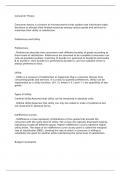Summary
Summary Consumer theory
- Course
- Econ1010 (ECON)
- Institution
- Trent University (TrentU )
These notes offer a thorough overview of key concepts in Consumer Theory, which is a fundamental area of microeconomics. The notes are divided into three main sections: Preferences and Utility, Budget Constraints, and Consumer Choice and Demand Curves. They are designed to be an essential resource ...
[Show more]



